Improving Accounting System at Borger Management Inc.: A Project
VerifiedAdded on 2019/09/30
|9
|3318
|265
Project
AI Summary
This project analyzes the accounting system of Borger Management, Inc., a property management company facing challenges due to the use of multiple incompatible accounting software systems. The company's current process involves manual data conversion, leading to errors, high consultant costs, and delayed financial reporting. The project outlines the problem, affected business activities, and the performance gap. It then details the requirements for a new system, including stakeholder considerations, business environment factors, new capabilities, cost limitations, and security requirements. The project explores four alternative solutions: hiring an in-house staff, hiring a software designer, using Software as a Service (SaaS), and renegotiating with consultants. It provides a risk assessment for each solution, evaluating the probability and impact of potential risks. The project concludes by ranking the solutions and suggesting that a single integrated accounting system would improve efficiency, reduce costs, and enhance the accuracy of financial reporting. The project suggests that the most promising solution is to hire a software designer to create a new accounting system and use it to replace the current system.
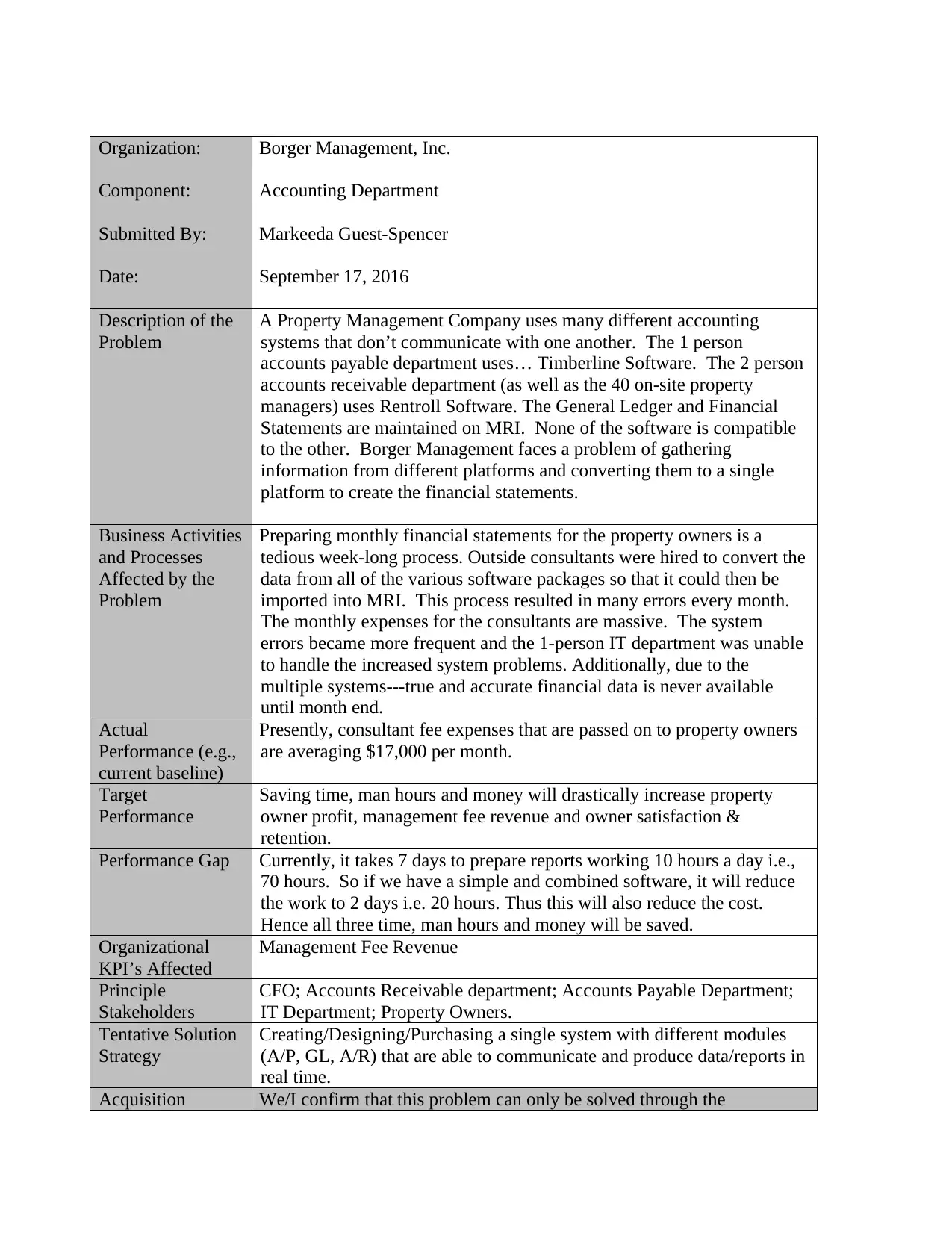
Organization:
Component:
Submitted By:
Date:
Borger Management, Inc.
Accounting Department
Markeeda Guest-Spencer
September 17, 2016
Description of the
Problem
A Property Management Company uses many different accounting
systems that don’t communicate with one another. The 1 person
accounts payable department uses… Timberline Software. The 2 person
accounts receivable department (as well as the 40 on-site property
managers) uses Rentroll Software. The General Ledger and Financial
Statements are maintained on MRI. None of the software is compatible
to the other. Borger Management faces a problem of gathering
information from different platforms and converting them to a single
platform to create the financial statements.
Business Activities
and Processes
Affected by the
Problem
Preparing monthly financial statements for the property owners is a
tedious week-long process. Outside consultants were hired to convert the
data from all of the various software packages so that it could then be
imported into MRI. This process resulted in many errors every month.
The monthly expenses for the consultants are massive. The system
errors became more frequent and the 1-person IT department was unable
to handle the increased system problems. Additionally, due to the
multiple systems---true and accurate financial data is never available
until month end.
Actual
Performance (e.g.,
current baseline)
Presently, consultant fee expenses that are passed on to property owners
are averaging $17,000 per month.
Target
Performance
Saving time, man hours and money will drastically increase property
owner profit, management fee revenue and owner satisfaction &
retention.
Performance Gap Currently, it takes 7 days to prepare reports working 10 hours a day i.e.,
70 hours. So if we have a simple and combined software, it will reduce
the work to 2 days i.e. 20 hours. Thus this will also reduce the cost.
Hence all three time, man hours and money will be saved.
Organizational
KPI’s Affected
Management Fee Revenue
Principle
Stakeholders
CFO; Accounts Receivable department; Accounts Payable Department;
IT Department; Property Owners.
Tentative Solution
Strategy
Creating/Designing/Purchasing a single system with different modules
(A/P, GL, A/R) that are able to communicate and produce data/reports in
real time.
Acquisition We/I confirm that this problem can only be solved through the
Component:
Submitted By:
Date:
Borger Management, Inc.
Accounting Department
Markeeda Guest-Spencer
September 17, 2016
Description of the
Problem
A Property Management Company uses many different accounting
systems that don’t communicate with one another. The 1 person
accounts payable department uses… Timberline Software. The 2 person
accounts receivable department (as well as the 40 on-site property
managers) uses Rentroll Software. The General Ledger and Financial
Statements are maintained on MRI. None of the software is compatible
to the other. Borger Management faces a problem of gathering
information from different platforms and converting them to a single
platform to create the financial statements.
Business Activities
and Processes
Affected by the
Problem
Preparing monthly financial statements for the property owners is a
tedious week-long process. Outside consultants were hired to convert the
data from all of the various software packages so that it could then be
imported into MRI. This process resulted in many errors every month.
The monthly expenses for the consultants are massive. The system
errors became more frequent and the 1-person IT department was unable
to handle the increased system problems. Additionally, due to the
multiple systems---true and accurate financial data is never available
until month end.
Actual
Performance (e.g.,
current baseline)
Presently, consultant fee expenses that are passed on to property owners
are averaging $17,000 per month.
Target
Performance
Saving time, man hours and money will drastically increase property
owner profit, management fee revenue and owner satisfaction &
retention.
Performance Gap Currently, it takes 7 days to prepare reports working 10 hours a day i.e.,
70 hours. So if we have a simple and combined software, it will reduce
the work to 2 days i.e. 20 hours. Thus this will also reduce the cost.
Hence all three time, man hours and money will be saved.
Organizational
KPI’s Affected
Management Fee Revenue
Principle
Stakeholders
CFO; Accounts Receivable department; Accounts Payable Department;
IT Department; Property Owners.
Tentative Solution
Strategy
Creating/Designing/Purchasing a single system with different modules
(A/P, GL, A/R) that are able to communicate and produce data/reports in
real time.
Acquisition We/I confirm that this problem can only be solved through the
Paraphrase This Document
Need a fresh take? Get an instant paraphrase of this document with our AI Paraphraser
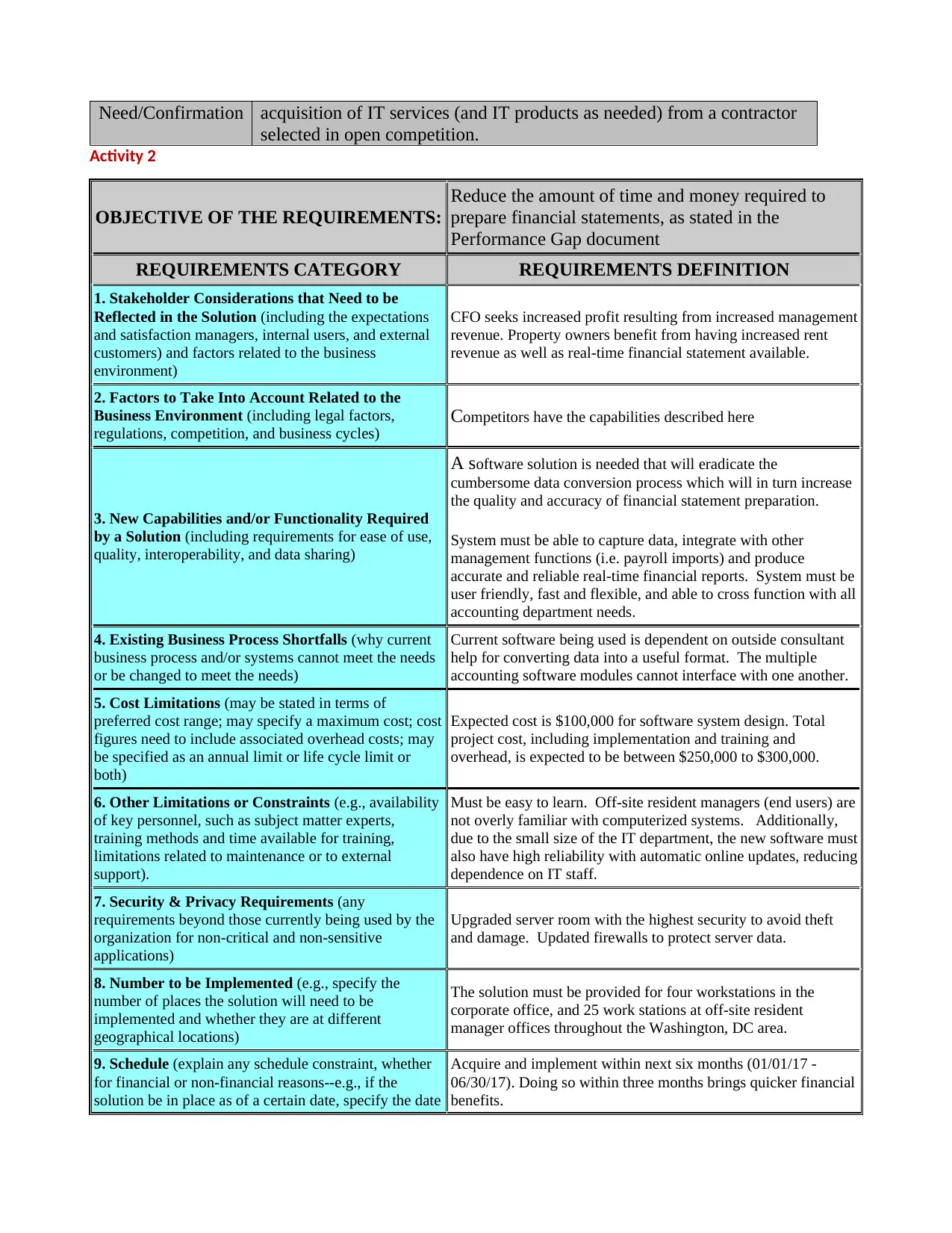
Need/Confirmation acquisition of IT services (and IT products as needed) from a contractor
selected in open competition.
Activity 2
OBJECTIVE OF THE REQUIREMENTS:
Reduce the amount of time and money required to
prepare financial statements, as stated in the
Performance Gap document
REQUIREMENTS CATEGORY REQUIREMENTS DEFINITION
1. Stakeholder Considerations that Need to be
Reflected in the Solution (including the expectations
and satisfaction managers, internal users, and external
customers) and factors related to the business
environment)
CFO seeks increased profit resulting from increased management
revenue. Property owners benefit from having increased rent
revenue as well as real-time financial statement available.
2. Factors to Take Into Account Related to the
Business Environment (including legal factors,
regulations, competition, and business cycles)
Competitors have the capabilities described here
3. New Capabilities and/or Functionality Required
by a Solution (including requirements for ease of use,
quality, interoperability, and data sharing)
A software solution is needed that will eradicate the
cumbersome data conversion process which will in turn increase
the quality and accuracy of financial statement preparation.
System must be able to capture data, integrate with other
management functions (i.e. payroll imports) and produce
accurate and reliable real-time financial reports. System must be
user friendly, fast and flexible, and able to cross function with all
accounting department needs.
4. Existing Business Process Shortfalls (why current
business process and/or systems cannot meet the needs
or be changed to meet the needs)
Current software being used is dependent on outside consultant
help for converting data into a useful format. The multiple
accounting software modules cannot interface with one another.
5. Cost Limitations (may be stated in terms of
preferred cost range; may specify a maximum cost; cost
figures need to include associated overhead costs; may
be specified as an annual limit or life cycle limit or
both)
Expected cost is $100,000 for software system design. Total
project cost, including implementation and training and
overhead, is expected to be between $250,000 to $300,000.
6. Other Limitations or Constraints (e.g., availability
of key personnel, such as subject matter experts,
training methods and time available for training,
limitations related to maintenance or to external
support).
Must be easy to learn. Off-site resident managers (end users) are
not overly familiar with computerized systems. Additionally,
due to the small size of the IT department, the new software must
also have high reliability with automatic online updates, reducing
dependence on IT staff.
7. Security & Privacy Requirements (any
requirements beyond those currently being used by the
organization for non-critical and non-sensitive
applications)
Upgraded server room with the highest security to avoid theft
and damage. Updated firewalls to protect server data.
8. Number to be Implemented (e.g., specify the
number of places the solution will need to be
implemented and whether they are at different
geographical locations)
The solution must be provided for four workstations in the
corporate office, and 25 work stations at off-site resident
manager offices throughout the Washington, DC area.
9. Schedule (explain any schedule constraint, whether
for financial or non-financial reasons--e.g., if the
solution be in place as of a certain date, specify the date
Acquire and implement within next six months (01/01/17 -
06/30/17). Doing so within three months brings quicker financial
benefits.
selected in open competition.
Activity 2
OBJECTIVE OF THE REQUIREMENTS:
Reduce the amount of time and money required to
prepare financial statements, as stated in the
Performance Gap document
REQUIREMENTS CATEGORY REQUIREMENTS DEFINITION
1. Stakeholder Considerations that Need to be
Reflected in the Solution (including the expectations
and satisfaction managers, internal users, and external
customers) and factors related to the business
environment)
CFO seeks increased profit resulting from increased management
revenue. Property owners benefit from having increased rent
revenue as well as real-time financial statement available.
2. Factors to Take Into Account Related to the
Business Environment (including legal factors,
regulations, competition, and business cycles)
Competitors have the capabilities described here
3. New Capabilities and/or Functionality Required
by a Solution (including requirements for ease of use,
quality, interoperability, and data sharing)
A software solution is needed that will eradicate the
cumbersome data conversion process which will in turn increase
the quality and accuracy of financial statement preparation.
System must be able to capture data, integrate with other
management functions (i.e. payroll imports) and produce
accurate and reliable real-time financial reports. System must be
user friendly, fast and flexible, and able to cross function with all
accounting department needs.
4. Existing Business Process Shortfalls (why current
business process and/or systems cannot meet the needs
or be changed to meet the needs)
Current software being used is dependent on outside consultant
help for converting data into a useful format. The multiple
accounting software modules cannot interface with one another.
5. Cost Limitations (may be stated in terms of
preferred cost range; may specify a maximum cost; cost
figures need to include associated overhead costs; may
be specified as an annual limit or life cycle limit or
both)
Expected cost is $100,000 for software system design. Total
project cost, including implementation and training and
overhead, is expected to be between $250,000 to $300,000.
6. Other Limitations or Constraints (e.g., availability
of key personnel, such as subject matter experts,
training methods and time available for training,
limitations related to maintenance or to external
support).
Must be easy to learn. Off-site resident managers (end users) are
not overly familiar with computerized systems. Additionally,
due to the small size of the IT department, the new software must
also have high reliability with automatic online updates, reducing
dependence on IT staff.
7. Security & Privacy Requirements (any
requirements beyond those currently being used by the
organization for non-critical and non-sensitive
applications)
Upgraded server room with the highest security to avoid theft
and damage. Updated firewalls to protect server data.
8. Number to be Implemented (e.g., specify the
number of places the solution will need to be
implemented and whether they are at different
geographical locations)
The solution must be provided for four workstations in the
corporate office, and 25 work stations at off-site resident
manager offices throughout the Washington, DC area.
9. Schedule (explain any schedule constraint, whether
for financial or non-financial reasons--e.g., if the
solution be in place as of a certain date, specify the date
Acquire and implement within next six months (01/01/17 -
06/30/17). Doing so within three months brings quicker financial
benefits.
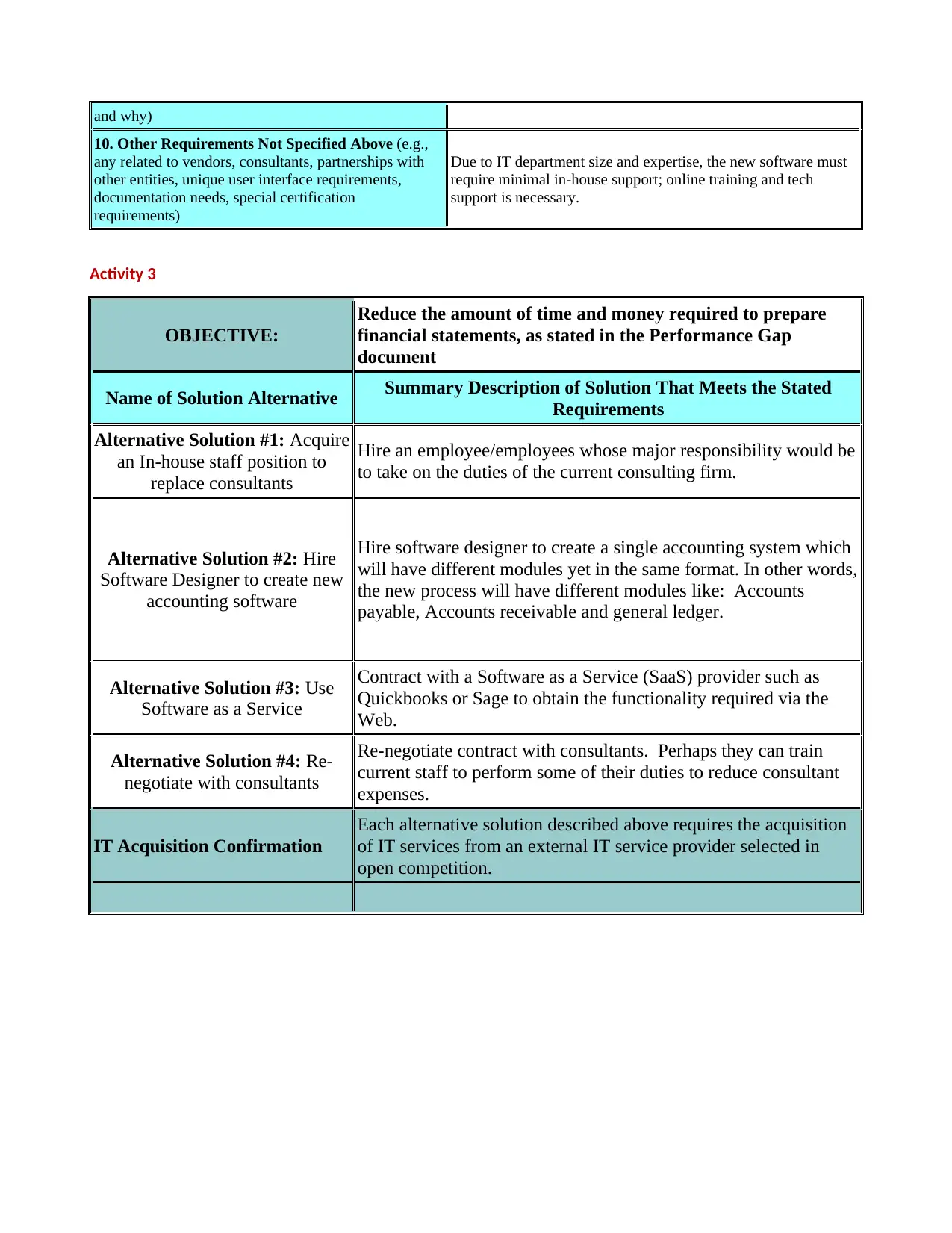
and why)
10. Other Requirements Not Specified Above (e.g.,
any related to vendors, consultants, partnerships with
other entities, unique user interface requirements,
documentation needs, special certification
requirements)
Due to IT department size and expertise, the new software must
require minimal in-house support; online training and tech
support is necessary.
Activity 3
OBJECTIVE:
Reduce the amount of time and money required to prepare
financial statements, as stated in the Performance Gap
document
Name of Solution Alternative Summary Description of Solution That Meets the Stated
Requirements
Alternative Solution #1: Acquire
an In-house staff position to
replace consultants
Hire an employee/employees whose major responsibility would be
to take on the duties of the current consulting firm.
Alternative Solution #2: Hire
Software Designer to create new
accounting software
Hire software designer to create a single accounting system which
will have different modules yet in the same format. In other words,
the new process will have different modules like: Accounts
payable, Accounts receivable and general ledger.
Alternative Solution #3: Use
Software as a Service
Contract with a Software as a Service (SaaS) provider such as
Quickbooks or Sage to obtain the functionality required via the
Web.
Alternative Solution #4: Re-
negotiate with consultants
Re-negotiate contract with consultants. Perhaps they can train
current staff to perform some of their duties to reduce consultant
expenses.
IT Acquisition Confirmation
Each alternative solution described above requires the acquisition
of IT services from an external IT service provider selected in
open competition.
10. Other Requirements Not Specified Above (e.g.,
any related to vendors, consultants, partnerships with
other entities, unique user interface requirements,
documentation needs, special certification
requirements)
Due to IT department size and expertise, the new software must
require minimal in-house support; online training and tech
support is necessary.
Activity 3
OBJECTIVE:
Reduce the amount of time and money required to prepare
financial statements, as stated in the Performance Gap
document
Name of Solution Alternative Summary Description of Solution That Meets the Stated
Requirements
Alternative Solution #1: Acquire
an In-house staff position to
replace consultants
Hire an employee/employees whose major responsibility would be
to take on the duties of the current consulting firm.
Alternative Solution #2: Hire
Software Designer to create new
accounting software
Hire software designer to create a single accounting system which
will have different modules yet in the same format. In other words,
the new process will have different modules like: Accounts
payable, Accounts receivable and general ledger.
Alternative Solution #3: Use
Software as a Service
Contract with a Software as a Service (SaaS) provider such as
Quickbooks or Sage to obtain the functionality required via the
Web.
Alternative Solution #4: Re-
negotiate with consultants
Re-negotiate contract with consultants. Perhaps they can train
current staff to perform some of their duties to reduce consultant
expenses.
IT Acquisition Confirmation
Each alternative solution described above requires the acquisition
of IT services from an external IT service provider selected in
open competition.
⊘ This is a preview!⊘
Do you want full access?
Subscribe today to unlock all pages.

Trusted by 1+ million students worldwide
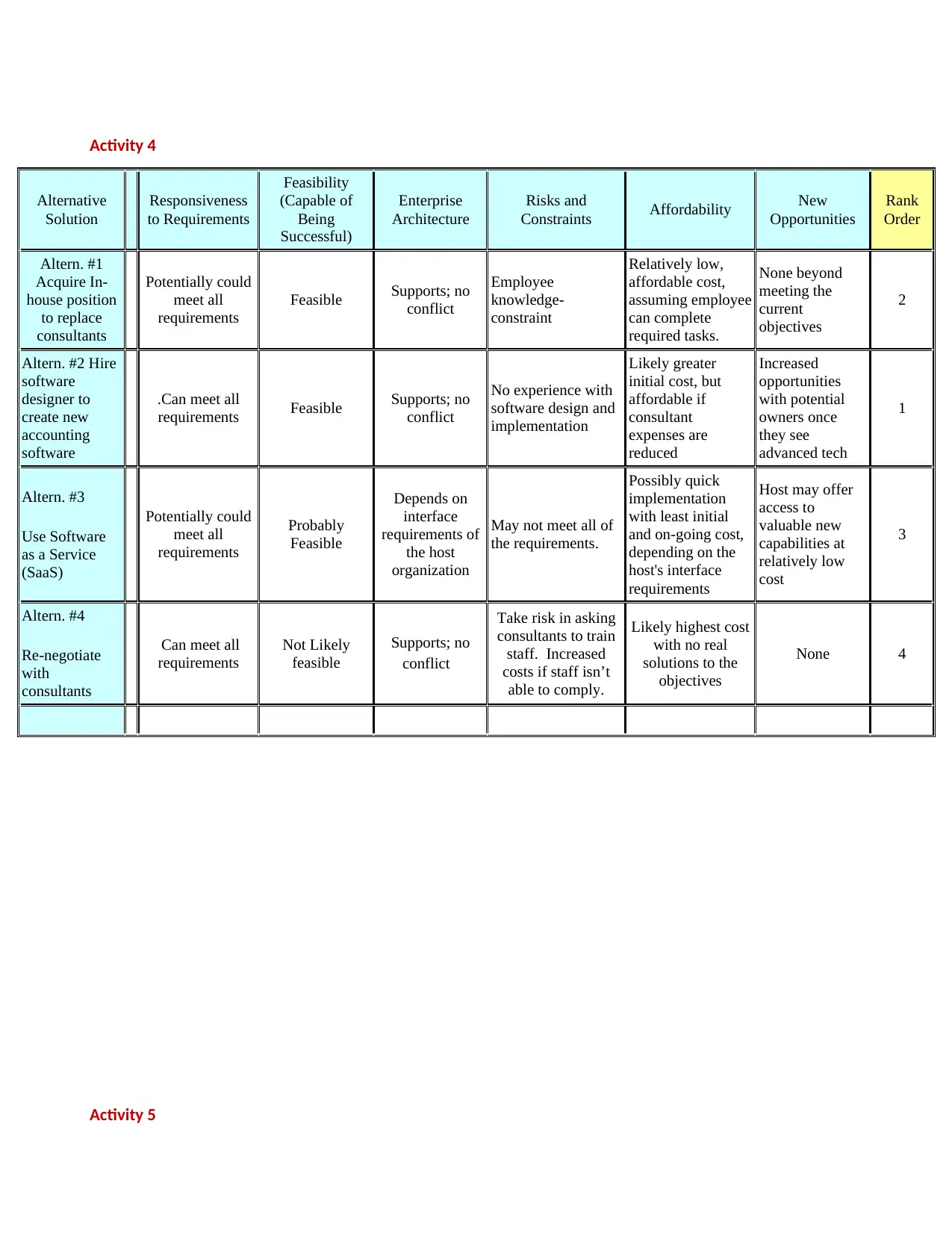
Activity 4
Alternative
Solution
Responsiveness
to Requirements
Feasibility
(Capable of
Being
Successful)
Enterprise
Architecture
Risks and
Constraints Affordability New
Opportunities
Rank
Order
Altern. #1
Acquire In-
house position
to replace
consultants
Potentially could
meet all
requirements
Feasible Supports; no
conflict
Employee
knowledge-
constraint
Relatively low,
affordable cost,
assuming employee
can complete
required tasks.
None beyond
meeting the
current
objectives
2
Altern. #2 Hire
software
designer to
create new
accounting
software
.Can meet all
requirements Feasible Supports; no
conflict
No experience with
software design and
implementation
Likely greater
initial cost, but
affordable if
consultant
expenses are
reduced
Increased
opportunities
with potential
owners once
they see
advanced tech
1
Altern. #3
Use Software
as a Service
(SaaS)
Potentially could
meet all
requirements
Probably
Feasible
Depends on
interface
requirements of
the host
organization
May not meet all of
the requirements.
Possibly quick
implementation
with least initial
and on-going cost,
depending on the
host's interface
requirements
Host may offer
access to
valuable new
capabilities at
relatively low
cost
3
Altern. #4
Re-negotiate
with
consultants
.Can meet all
requirements
Not Likely
feasible
Supports; no
conflict .
Take risk in asking
consultants to train
staff. Increased
costs if staff isn’t
able to comply.
Likely highest cost
with no real
solutions to the
objectives
None 4
Activity 5
Alternative
Solution
Responsiveness
to Requirements
Feasibility
(Capable of
Being
Successful)
Enterprise
Architecture
Risks and
Constraints Affordability New
Opportunities
Rank
Order
Altern. #1
Acquire In-
house position
to replace
consultants
Potentially could
meet all
requirements
Feasible Supports; no
conflict
Employee
knowledge-
constraint
Relatively low,
affordable cost,
assuming employee
can complete
required tasks.
None beyond
meeting the
current
objectives
2
Altern. #2 Hire
software
designer to
create new
accounting
software
.Can meet all
requirements Feasible Supports; no
conflict
No experience with
software design and
implementation
Likely greater
initial cost, but
affordable if
consultant
expenses are
reduced
Increased
opportunities
with potential
owners once
they see
advanced tech
1
Altern. #3
Use Software
as a Service
(SaaS)
Potentially could
meet all
requirements
Probably
Feasible
Depends on
interface
requirements of
the host
organization
May not meet all of
the requirements.
Possibly quick
implementation
with least initial
and on-going cost,
depending on the
host's interface
requirements
Host may offer
access to
valuable new
capabilities at
relatively low
cost
3
Altern. #4
Re-negotiate
with
consultants
.Can meet all
requirements
Not Likely
feasible
Supports; no
conflict .
Take risk in asking
consultants to train
staff. Increased
costs if staff isn’t
able to comply.
Likely highest cost
with no real
solutions to the
objectives
None 4
Activity 5
Paraphrase This Document
Need a fresh take? Get an instant paraphrase of this document with our AI Paraphraser
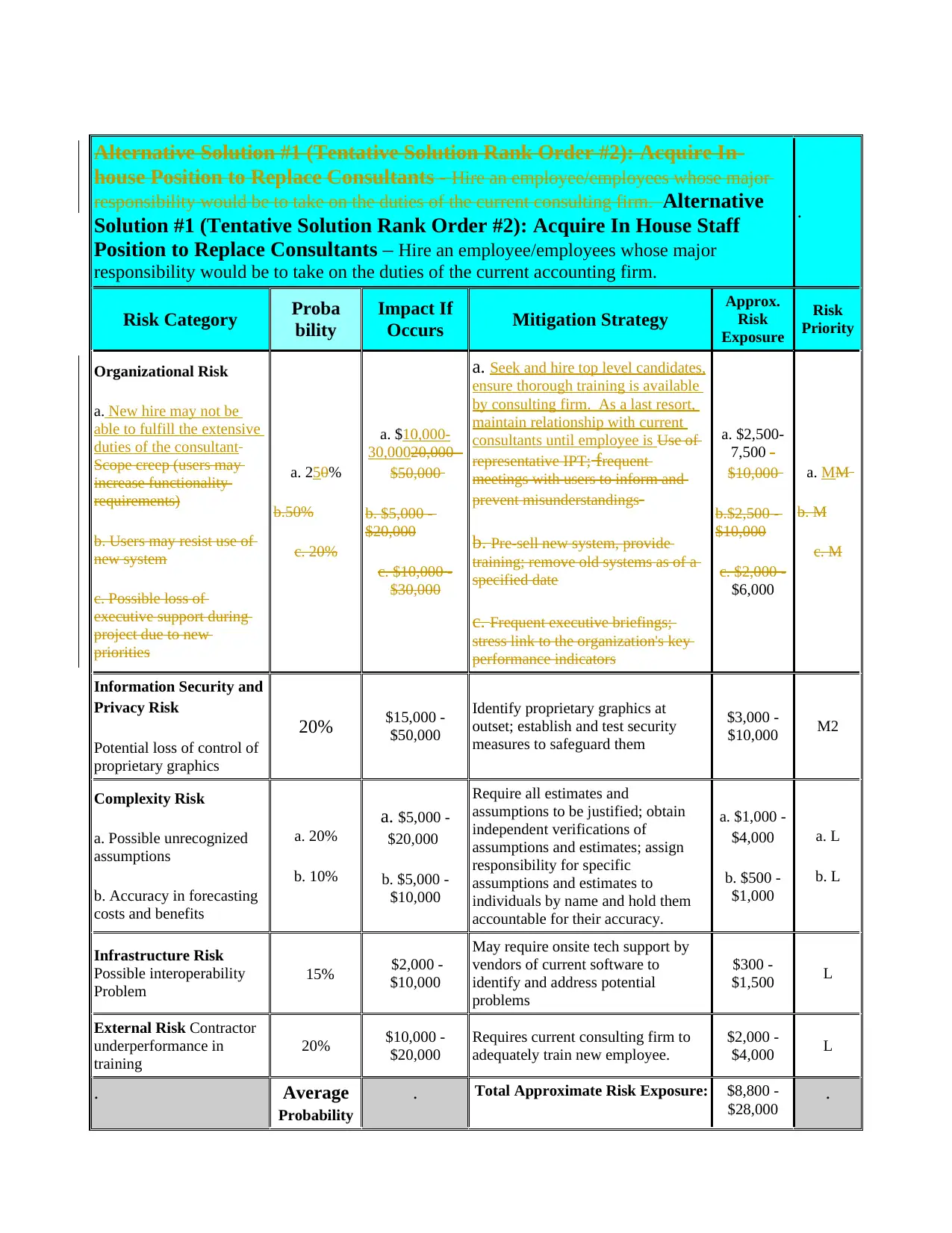
Alternative Solution #1 (Tentative Solution Rank Order #2): Acquire In-
house Position to Replace Consultants - Hire an employee/employees whose major
responsibility would be to take on the duties of the current consulting firm. Alternative
Solution #1 (Tentative Solution Rank Order #2): Acquire In House Staff
Position to Replace Consultants – Hire an employee/employees whose major
responsibility would be to take on the duties of the current accounting firm.
.
Risk Category Proba
bility
Impact If
Occurs Mitigation Strategy
Approx.
Risk
Exposure
Risk
Priority
Organizational Risk
a. New hire may not be
able to fulfill the extensive
duties of the consultant
Scope creep (users may
increase functionality
requirements)
b. Users may resist use of
new system
c. Possible loss of
executive support during
project due to new
priorities
a. 250%
b.50%
c. 20%
a. $10,000-
30,00020,000 -
$50,000
b. $5,000 -
$20,000
c. $10,000 -
$30,000
a. Seek and hire top level candidates,
ensure thorough training is available
by consulting firm. As a last resort,
maintain relationship with current
consultants until employee is Use of
representative IPT; frequent
meetings with users to inform and
prevent misunderstandings
b. Pre-sell new system, provide
training; remove old systems as of a
specified date
c. Frequent executive briefings;
stress link to the organization's key
performance indicators
a. $2,500-
7,500 -
$10,000
b.$2,500 -
$10,000
c. $2,000 -
$6,000
a. MM
b. M
c. M
Information Security and
Privacy Risk
Potential loss of control of
proprietary graphics
20% $15,000 -
$50,000
Identify proprietary graphics at
outset; establish and test security
measures to safeguard them
$3,000 -
$10,000 M2
Complexity Risk
a. Possible unrecognized
assumptions
b. Accuracy in forecasting
costs and benefits
a. 20%
b. 10%
a. $5,000 -
$20,000.
b. $5,000 -
$10,000
Require all estimates and
assumptions to be justified; obtain
independent verifications of
assumptions and estimates; assign
responsibility for specific
assumptions and estimates to
individuals by name and hold them
accountable for their accuracy.
a. $1,000 -
$4,000
b. $500 -
$1,000
a. L
b. L
Infrastructure Risk
Possible interoperability
Problem
. 15% .$2,000 -
$10,000
May require onsite tech support by
vendors of current software to
identify and address potential
problems
$300 -
$1,500 L
External Risk Contractor
underperformance in
training
20% $10,000 -
$20,000
Requires current consulting firm to
adequately train new employee.
$2,000 -
$4,000 L
. Average
Probability
. Total Approximate Risk Exposure: $8,800 -
$28,000 .
house Position to Replace Consultants - Hire an employee/employees whose major
responsibility would be to take on the duties of the current consulting firm. Alternative
Solution #1 (Tentative Solution Rank Order #2): Acquire In House Staff
Position to Replace Consultants – Hire an employee/employees whose major
responsibility would be to take on the duties of the current accounting firm.
.
Risk Category Proba
bility
Impact If
Occurs Mitigation Strategy
Approx.
Risk
Exposure
Risk
Priority
Organizational Risk
a. New hire may not be
able to fulfill the extensive
duties of the consultant
Scope creep (users may
increase functionality
requirements)
b. Users may resist use of
new system
c. Possible loss of
executive support during
project due to new
priorities
a. 250%
b.50%
c. 20%
a. $10,000-
30,00020,000 -
$50,000
b. $5,000 -
$20,000
c. $10,000 -
$30,000
a. Seek and hire top level candidates,
ensure thorough training is available
by consulting firm. As a last resort,
maintain relationship with current
consultants until employee is Use of
representative IPT; frequent
meetings with users to inform and
prevent misunderstandings
b. Pre-sell new system, provide
training; remove old systems as of a
specified date
c. Frequent executive briefings;
stress link to the organization's key
performance indicators
a. $2,500-
7,500 -
$10,000
b.$2,500 -
$10,000
c. $2,000 -
$6,000
a. MM
b. M
c. M
Information Security and
Privacy Risk
Potential loss of control of
proprietary graphics
20% $15,000 -
$50,000
Identify proprietary graphics at
outset; establish and test security
measures to safeguard them
$3,000 -
$10,000 M2
Complexity Risk
a. Possible unrecognized
assumptions
b. Accuracy in forecasting
costs and benefits
a. 20%
b. 10%
a. $5,000 -
$20,000.
b. $5,000 -
$10,000
Require all estimates and
assumptions to be justified; obtain
independent verifications of
assumptions and estimates; assign
responsibility for specific
assumptions and estimates to
individuals by name and hold them
accountable for their accuracy.
a. $1,000 -
$4,000
b. $500 -
$1,000
a. L
b. L
Infrastructure Risk
Possible interoperability
Problem
. 15% .$2,000 -
$10,000
May require onsite tech support by
vendors of current software to
identify and address potential
problems
$300 -
$1,500 L
External Risk Contractor
underperformance in
training
20% $10,000 -
$20,000
Requires current consulting firm to
adequately train new employee.
$2,000 -
$4,000 L
. Average
Probability
. Total Approximate Risk Exposure: $8,800 -
$28,000 .
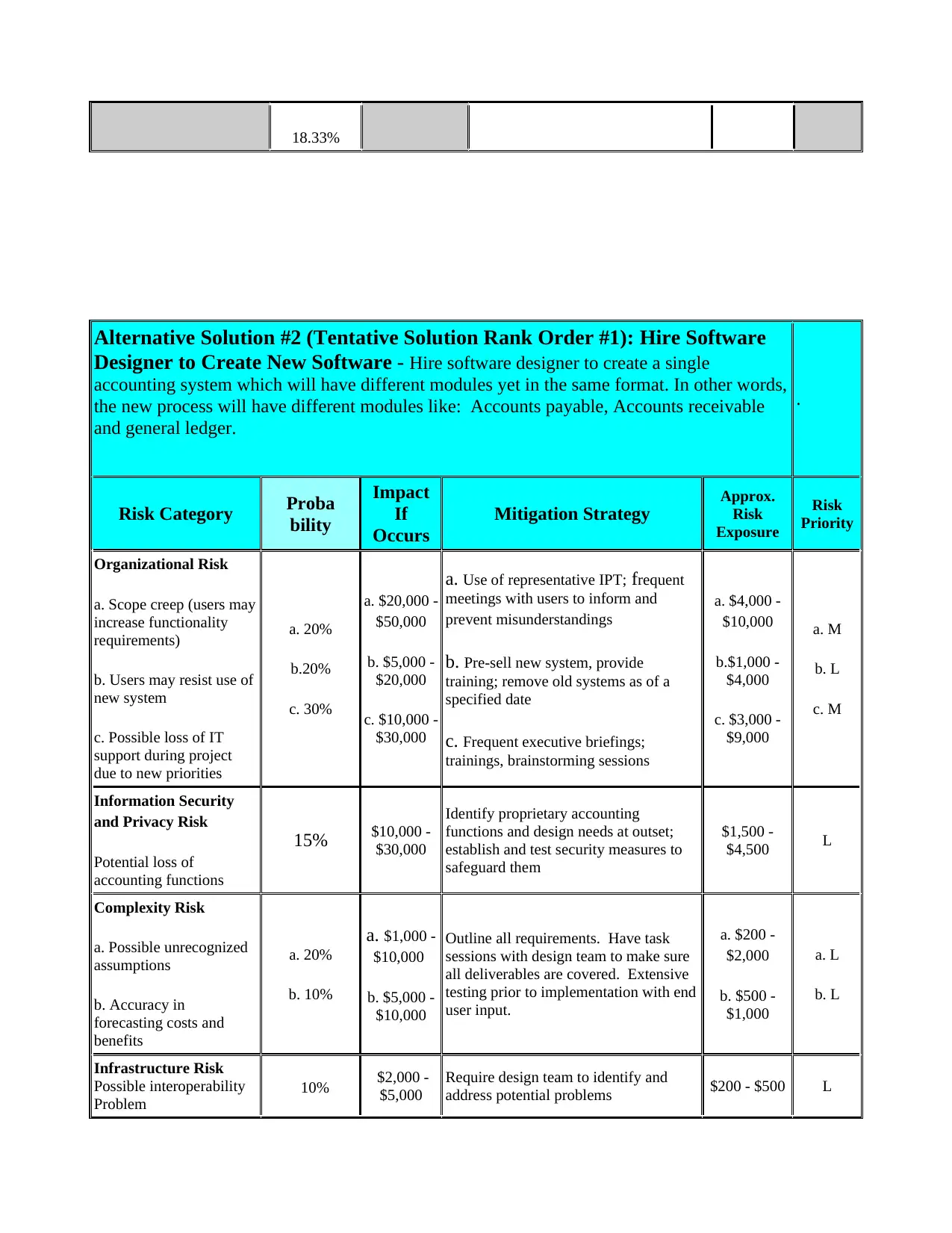
18.33%
Alternative Solution #2 (Tentative Solution Rank Order #1): Hire Software
Designer to Create New Software - Hire software designer to create a single
accounting system which will have different modules yet in the same format. In other words,
the new process will have different modules like: Accounts payable, Accounts receivable
and general ledger.
.
Risk Category Proba
bility
Impact
If
Occurs
Mitigation Strategy
Approx.
Risk
Exposure
Risk
Priority
Organizational Risk
a. Scope creep (users may
increase functionality
requirements)
b. Users may resist use of
new system
c. Possible loss of IT
support during project
due to new priorities
a. 20%
b.20%
c. 30%
a. $20,000 -
$50,000
b. $5,000 -
$20,000
c. $10,000 -
$30,000
a. Use of representative IPT; frequent
meetings with users to inform and
prevent misunderstandings
b. Pre-sell new system, provide
training; remove old systems as of a
specified date
c. Frequent executive briefings;
trainings, brainstorming sessions
a. $4,000 -
$10,000
b.$1,000 -
$4,000
c. $3,000 -
$9,000
a. M
b. L
c. M
Information Security
and Privacy Risk
Potential loss of
accounting functions
15% $10,000 -
$30,000
Identify proprietary accounting
functions and design needs at outset;
establish and test security measures to
safeguard them
$1,500 -
$4,500 L
Complexity Risk
a. Possible unrecognized
assumptions
b. Accuracy in
forecasting costs and
benefits
a. 20%
b. 10%
a. $1,000 -
$10,000.
b. $5,000 -
$10,000
Outline all requirements. Have task
sessions with design team to make sure
all deliverables are covered. Extensive
testing prior to implementation with end
user input.
a. $200 -
$2,000
b. $500 -
$1,000
a. L
b. L
Infrastructure Risk
Possible interoperability
Problem
. 10% .$2,000 -
$5,000
Require design team to identify and
address potential problems $200 - $500 L
Alternative Solution #2 (Tentative Solution Rank Order #1): Hire Software
Designer to Create New Software - Hire software designer to create a single
accounting system which will have different modules yet in the same format. In other words,
the new process will have different modules like: Accounts payable, Accounts receivable
and general ledger.
.
Risk Category Proba
bility
Impact
If
Occurs
Mitigation Strategy
Approx.
Risk
Exposure
Risk
Priority
Organizational Risk
a. Scope creep (users may
increase functionality
requirements)
b. Users may resist use of
new system
c. Possible loss of IT
support during project
due to new priorities
a. 20%
b.20%
c. 30%
a. $20,000 -
$50,000
b. $5,000 -
$20,000
c. $10,000 -
$30,000
a. Use of representative IPT; frequent
meetings with users to inform and
prevent misunderstandings
b. Pre-sell new system, provide
training; remove old systems as of a
specified date
c. Frequent executive briefings;
trainings, brainstorming sessions
a. $4,000 -
$10,000
b.$1,000 -
$4,000
c. $3,000 -
$9,000
a. M
b. L
c. M
Information Security
and Privacy Risk
Potential loss of
accounting functions
15% $10,000 -
$30,000
Identify proprietary accounting
functions and design needs at outset;
establish and test security measures to
safeguard them
$1,500 -
$4,500 L
Complexity Risk
a. Possible unrecognized
assumptions
b. Accuracy in
forecasting costs and
benefits
a. 20%
b. 10%
a. $1,000 -
$10,000.
b. $5,000 -
$10,000
Outline all requirements. Have task
sessions with design team to make sure
all deliverables are covered. Extensive
testing prior to implementation with end
user input.
a. $200 -
$2,000
b. $500 -
$1,000
a. L
b. L
Infrastructure Risk
Possible interoperability
Problem
. 10% .$2,000 -
$5,000
Require design team to identify and
address potential problems $200 - $500 L
⊘ This is a preview!⊘
Do you want full access?
Subscribe today to unlock all pages.

Trusted by 1+ million students worldwide
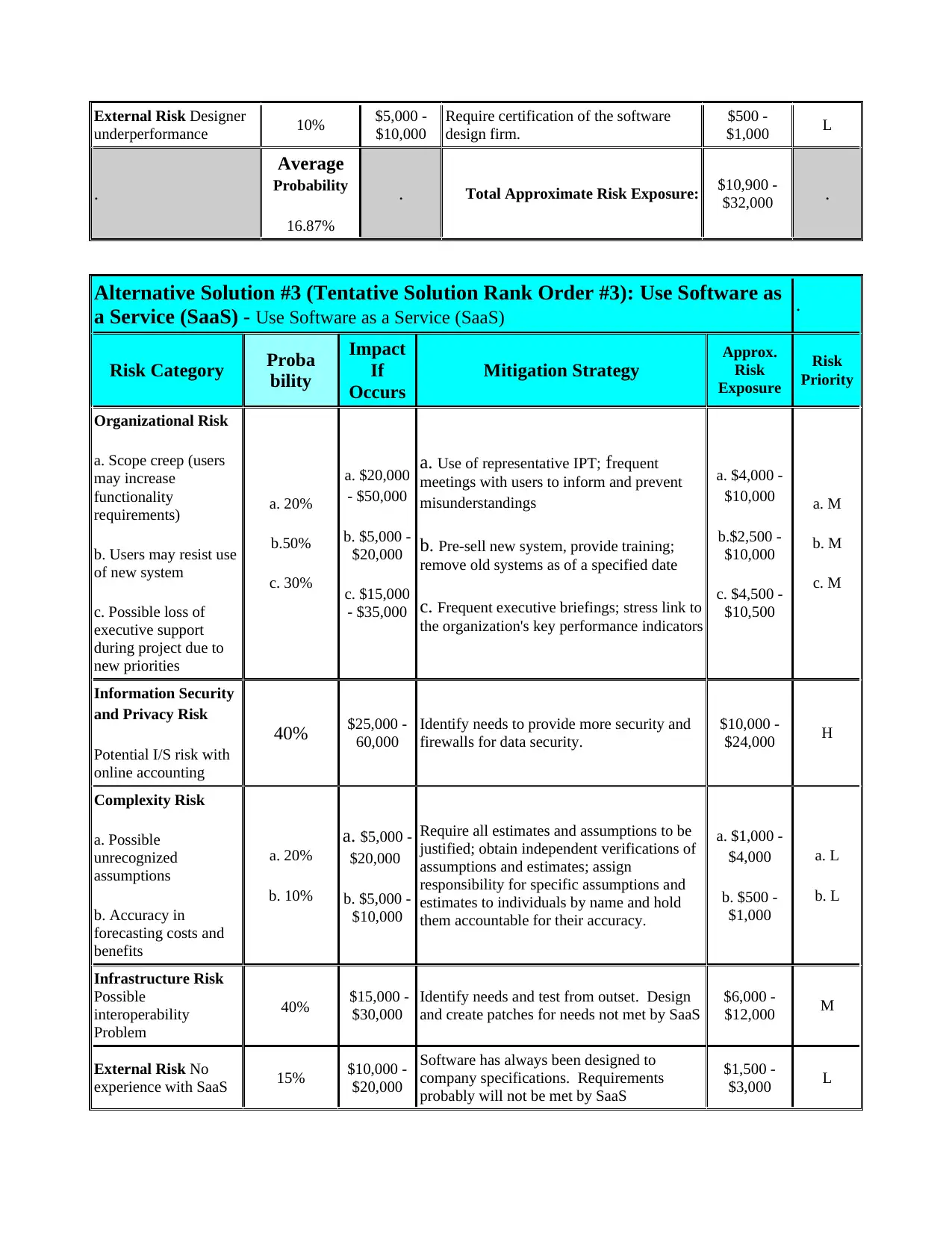
External Risk Designer
underperformance 10% $5,000 -
$10,000
Require certification of the software
design firm.
$500 -
$1,000 L
.
Average
Probability
16.87%
. Total Approximate Risk Exposure: $10,900 -
$32,000 .
Alternative Solution #3 (Tentative Solution Rank Order #3): Use Software as
a Service (SaaS) - Use Software as a Service (SaaS) .
Risk Category Proba
bility
Impact
If
Occurs
Mitigation Strategy
Approx.
Risk
Exposure
Risk
Priority
Organizational Risk
a. Scope creep (users
may increase
functionality
requirements)
b. Users may resist use
of new system
c. Possible loss of
executive support
during project due to
new priorities
a. 20%
b.50%
c. 30%
a. $20,000
- $50,000
b. $5,000 -
$20,000
c. $15,000
- $35,000
a. Use of representative IPT; frequent
meetings with users to inform and prevent
misunderstandings
b. Pre-sell new system, provide training;
remove old systems as of a specified date
c. Frequent executive briefings; stress link to
the organization's key performance indicators
a. $4,000 -
$10,000
b.$2,500 -
$10,000
c. $4,500 -
$10,500
a. M
b. M
c. M
Information Security
and Privacy Risk
Potential I/S risk with
online accounting
40% $25,000 -
60,000
Identify needs to provide more security and
firewalls for data security.
$10,000 -
$24,000 H
Complexity Risk
a. Possible
unrecognized
assumptions
b. Accuracy in
forecasting costs and
benefits
a. 20%
b. 10%
a. $5,000 -
$20,000.
b. $5,000 -
$10,000
Require all estimates and assumptions to be
justified; obtain independent verifications of
assumptions and estimates; assign
responsibility for specific assumptions and
estimates to individuals by name and hold
them accountable for their accuracy.
a. $1,000 -
$4,000
b. $500 -
$1,000
a. L
b. L
Infrastructure Risk
Possible
interoperability
Problem
. 40% .$15,000 -
$30,000
Identify needs and test from outset. Design
and create patches for needs not met by SaaS
$6,000 -
$12,000 M
External Risk No
experience with SaaS 15% $10,000 -
$20,000
Software has always been designed to
company specifications. Requirements
probably will not be met by SaaS
$1,500 -
$3,000 L
underperformance 10% $5,000 -
$10,000
Require certification of the software
design firm.
$500 -
$1,000 L
.
Average
Probability
16.87%
. Total Approximate Risk Exposure: $10,900 -
$32,000 .
Alternative Solution #3 (Tentative Solution Rank Order #3): Use Software as
a Service (SaaS) - Use Software as a Service (SaaS) .
Risk Category Proba
bility
Impact
If
Occurs
Mitigation Strategy
Approx.
Risk
Exposure
Risk
Priority
Organizational Risk
a. Scope creep (users
may increase
functionality
requirements)
b. Users may resist use
of new system
c. Possible loss of
executive support
during project due to
new priorities
a. 20%
b.50%
c. 30%
a. $20,000
- $50,000
b. $5,000 -
$20,000
c. $15,000
- $35,000
a. Use of representative IPT; frequent
meetings with users to inform and prevent
misunderstandings
b. Pre-sell new system, provide training;
remove old systems as of a specified date
c. Frequent executive briefings; stress link to
the organization's key performance indicators
a. $4,000 -
$10,000
b.$2,500 -
$10,000
c. $4,500 -
$10,500
a. M
b. M
c. M
Information Security
and Privacy Risk
Potential I/S risk with
online accounting
40% $25,000 -
60,000
Identify needs to provide more security and
firewalls for data security.
$10,000 -
$24,000 H
Complexity Risk
a. Possible
unrecognized
assumptions
b. Accuracy in
forecasting costs and
benefits
a. 20%
b. 10%
a. $5,000 -
$20,000.
b. $5,000 -
$10,000
Require all estimates and assumptions to be
justified; obtain independent verifications of
assumptions and estimates; assign
responsibility for specific assumptions and
estimates to individuals by name and hold
them accountable for their accuracy.
a. $1,000 -
$4,000
b. $500 -
$1,000
a. L
b. L
Infrastructure Risk
Possible
interoperability
Problem
. 40% .$15,000 -
$30,000
Identify needs and test from outset. Design
and create patches for needs not met by SaaS
$6,000 -
$12,000 M
External Risk No
experience with SaaS 15% $10,000 -
$20,000
Software has always been designed to
company specifications. Requirements
probably will not be met by SaaS
$1,500 -
$3,000 L
Paraphrase This Document
Need a fresh take? Get an instant paraphrase of this document with our AI Paraphraser
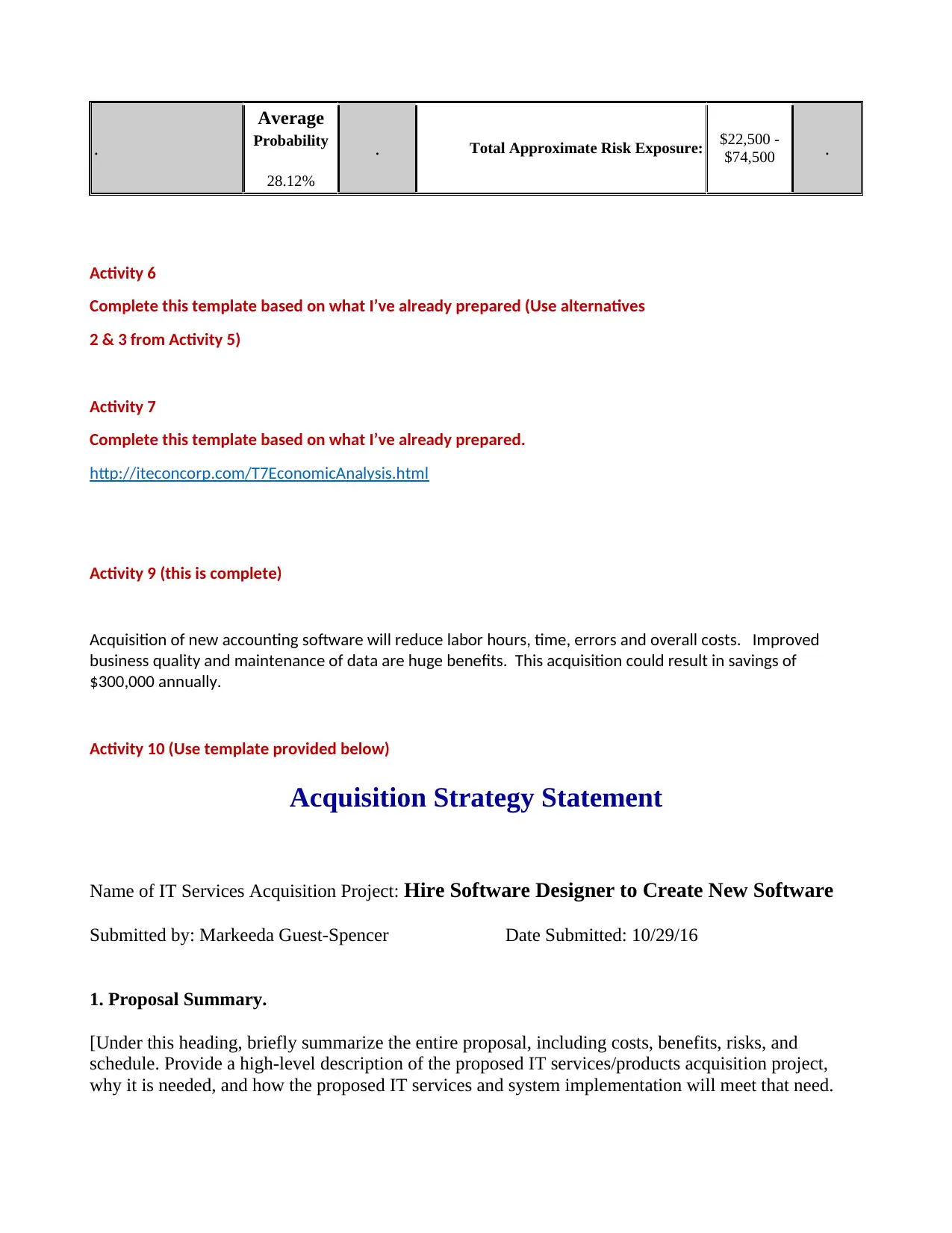
.
Average
Probability
28.12%
. Total Approximate Risk Exposure: $22,500 -
$74,500 .
Activity 6
Complete this template based on what I’ve already prepared (Use alternatives
2 & 3 from Activity 5)
Activity 7
Complete this template based on what I’ve already prepared.
http://iteconcorp.com/T7EconomicAnalysis.html
Activity 9 (this is complete)
Acquisition of new accounting software will reduce labor hours, time, errors and overall costs. Improved
business quality and maintenance of data are huge benefits. This acquisition could result in savings of
$300,000 annually.
Activity 10 (Use template provided below)
Acquisition Strategy Statement
Name of IT Services Acquisition Project: Hire Software Designer to Create New Software
Submitted by: Markeeda Guest-Spencer Date Submitted: 10/29/16
1. Proposal Summary.
[Under this heading, briefly summarize the entire proposal, including costs, benefits, risks, and
schedule. Provide a high-level description of the proposed IT services/products acquisition project,
why it is needed, and how the proposed IT services and system implementation will meet that need.
Average
Probability
28.12%
. Total Approximate Risk Exposure: $22,500 -
$74,500 .
Activity 6
Complete this template based on what I’ve already prepared (Use alternatives
2 & 3 from Activity 5)
Activity 7
Complete this template based on what I’ve already prepared.
http://iteconcorp.com/T7EconomicAnalysis.html
Activity 9 (this is complete)
Acquisition of new accounting software will reduce labor hours, time, errors and overall costs. Improved
business quality and maintenance of data are huge benefits. This acquisition could result in savings of
$300,000 annually.
Activity 10 (Use template provided below)
Acquisition Strategy Statement
Name of IT Services Acquisition Project: Hire Software Designer to Create New Software
Submitted by: Markeeda Guest-Spencer Date Submitted: 10/29/16
1. Proposal Summary.
[Under this heading, briefly summarize the entire proposal, including costs, benefits, risks, and
schedule. Provide a high-level description of the proposed IT services/products acquisition project,
why it is needed, and how the proposed IT services and system implementation will meet that need.
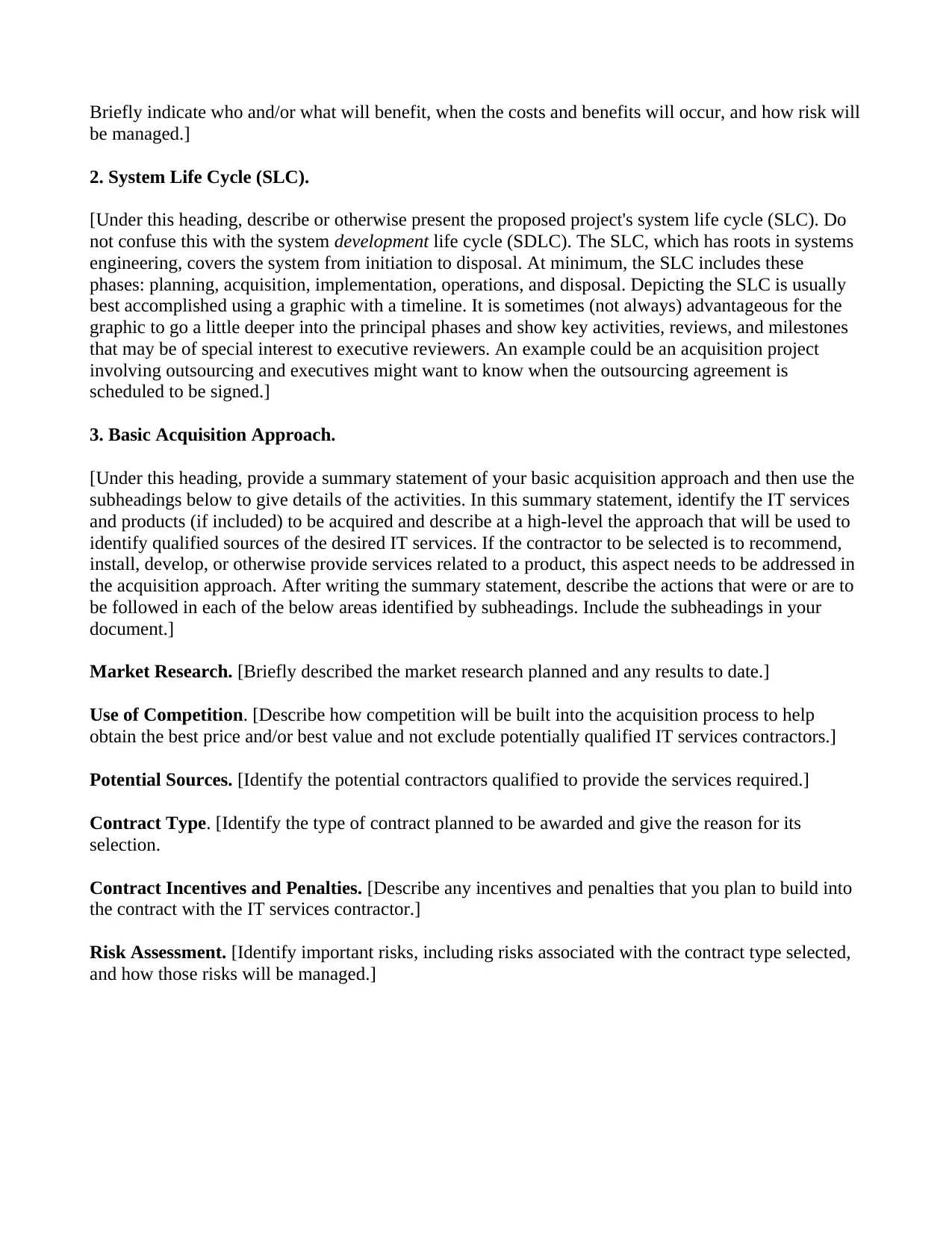
Briefly indicate who and/or what will benefit, when the costs and benefits will occur, and how risk will
be managed.]
2. System Life Cycle (SLC).
[Under this heading, describe or otherwise present the proposed project's system life cycle (SLC). Do
not confuse this with the system development life cycle (SDLC). The SLC, which has roots in systems
engineering, covers the system from initiation to disposal. At minimum, the SLC includes these
phases: planning, acquisition, implementation, operations, and disposal. Depicting the SLC is usually
best accomplished using a graphic with a timeline. It is sometimes (not always) advantageous for the
graphic to go a little deeper into the principal phases and show key activities, reviews, and milestones
that may be of special interest to executive reviewers. An example could be an acquisition project
involving outsourcing and executives might want to know when the outsourcing agreement is
scheduled to be signed.]
3. Basic Acquisition Approach.
[Under this heading, provide a summary statement of your basic acquisition approach and then use the
subheadings below to give details of the activities. In this summary statement, identify the IT services
and products (if included) to be acquired and describe at a high-level the approach that will be used to
identify qualified sources of the desired IT services. If the contractor to be selected is to recommend,
install, develop, or otherwise provide services related to a product, this aspect needs to be addressed in
the acquisition approach. After writing the summary statement, describe the actions that were or are to
be followed in each of the below areas identified by subheadings. Include the subheadings in your
document.]
Market Research. [Briefly described the market research planned and any results to date.]
Use of Competition. [Describe how competition will be built into the acquisition process to help
obtain the best price and/or best value and not exclude potentially qualified IT services contractors.]
Potential Sources. [Identify the potential contractors qualified to provide the services required.]
Contract Type. [Identify the type of contract planned to be awarded and give the reason for its
selection.
Contract Incentives and Penalties. [Describe any incentives and penalties that you plan to build into
the contract with the IT services contractor.]
Risk Assessment. [Identify important risks, including risks associated with the contract type selected,
and how those risks will be managed.]
be managed.]
2. System Life Cycle (SLC).
[Under this heading, describe or otherwise present the proposed project's system life cycle (SLC). Do
not confuse this with the system development life cycle (SDLC). The SLC, which has roots in systems
engineering, covers the system from initiation to disposal. At minimum, the SLC includes these
phases: planning, acquisition, implementation, operations, and disposal. Depicting the SLC is usually
best accomplished using a graphic with a timeline. It is sometimes (not always) advantageous for the
graphic to go a little deeper into the principal phases and show key activities, reviews, and milestones
that may be of special interest to executive reviewers. An example could be an acquisition project
involving outsourcing and executives might want to know when the outsourcing agreement is
scheduled to be signed.]
3. Basic Acquisition Approach.
[Under this heading, provide a summary statement of your basic acquisition approach and then use the
subheadings below to give details of the activities. In this summary statement, identify the IT services
and products (if included) to be acquired and describe at a high-level the approach that will be used to
identify qualified sources of the desired IT services. If the contractor to be selected is to recommend,
install, develop, or otherwise provide services related to a product, this aspect needs to be addressed in
the acquisition approach. After writing the summary statement, describe the actions that were or are to
be followed in each of the below areas identified by subheadings. Include the subheadings in your
document.]
Market Research. [Briefly described the market research planned and any results to date.]
Use of Competition. [Describe how competition will be built into the acquisition process to help
obtain the best price and/or best value and not exclude potentially qualified IT services contractors.]
Potential Sources. [Identify the potential contractors qualified to provide the services required.]
Contract Type. [Identify the type of contract planned to be awarded and give the reason for its
selection.
Contract Incentives and Penalties. [Describe any incentives and penalties that you plan to build into
the contract with the IT services contractor.]
Risk Assessment. [Identify important risks, including risks associated with the contract type selected,
and how those risks will be managed.]
⊘ This is a preview!⊘
Do you want full access?
Subscribe today to unlock all pages.

Trusted by 1+ million students worldwide
1 out of 9
Related Documents
Your All-in-One AI-Powered Toolkit for Academic Success.
+13062052269
info@desklib.com
Available 24*7 on WhatsApp / Email
![[object Object]](/_next/static/media/star-bottom.7253800d.svg)
Unlock your academic potential
Copyright © 2020–2025 A2Z Services. All Rights Reserved. Developed and managed by ZUCOL.





